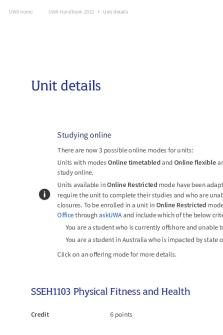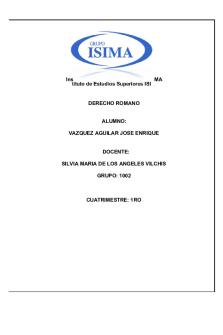Confirm physical health status HLTAP401A PDF

| Title | Confirm physical health status HLTAP401A |
|---|---|
| Course | Diploma of nursing |
| Institution | TAFE New South Wales |
| Pages | 8 |
| File Size | 414.4 KB |
| File Type | |
| Total Downloads | 102 |
| Total Views | 138 |
Summary
Confirm physical health status
HLTAP401A...
Description
Learner Resource Package Certificate IV in Nursing (Enrolled/Division 2 Nursing) 3262 Confirm physical health status HLTAP401A Version 1.1
Learner Resource
HLTAP401A Confirm physical health status V1.1
i
Acknowledgments TAFE NSW – Community Services, Health, Tourism and Recreation Curriculum Centre would like to acknowledge the support and assistance of the following people in the production of this resource package
Writers: Liz Bougaardt
Reviewer/Editor: Rhonda Albani Amanda Culver
Project Manager: Christine Manwarring Program Manager Health and Aged Services Acknowledgements are also given to all teachers of the Enrolled Nurse Education Program.
Enquiries: Enquiries about this and other publications can be made to: TAFE NSW - Community Services, Health, Tourism and Recreation Curriculum Centre Locked Bag No. 6 MEADOWBANK NSW 2114 Tel: 02-9942 3200 Fax: 02-9942 3257
© The State of New South Wales, Department of Education and Training, TAFE NSW, Community Services, Health, Tourism and Recreation Curriculum Centre, 2008. Copyright of this material is reserved to Community Services, Health, Tourism and Recreation Curriculum Centre, TAFE NSW. Reproduction or transmittal in whole or in part, other than for the purposes of private study or research, and subject to the provisions of the Copyright Act, is prohibited without the written authority of Community Services, Health, Tourism and Recreation Curriculum Centre, TAFE NSW. 978-0-7348-9012-2
HLTAP401A Confirm physical health status V1.1
v
TABLE OF CONTENTS INTRODUCTION ............................................................................................................................................................1 LEARNER INFORMATION.............................................................................................................................................2 TOPIC 1
Medical terminology ...............................................................................................................................9
TOPIC 2
Cell structure and function................................................................................................................... 25
TOPIC 3
Tissues/organs/systems ....................................................................................................................... 33
TOPIC 4
Normal anatomy and physiology of all body systems ................................................................. 41
TOPIC 5
Homeostasis......................................................................................................................................... 105
TOPIC 6
Causes of disease/environmental factors affecting health....................................................... 107
RESOURCE LIST........................................................................................................................................................ 109
HLTAP401A Confirm physical health status V1.1
9
TOPIC 1 Medical terminology Medical terminology is the professional language of those who are directly or indirectly engaged in the art of healing. The primary goal of introducing you to medical terminology is to help you develop the ability to read and understand the language of medicine. Most medical terms are derived from either Greek or Latin. For example Nephro (from the Greek, Nephros) and Ren (from the Latin, Ren) are both terms meaning the kidney. Some new medical words continue to use Latin derivatives for example vitamins, meaning life, but many have other sources, for example, German, French and Dutch languages. Many medical terms are combinations of components from ancient languages. As your vocabulary grows you will begin to notice patterns that employ some of these components. Over time, increased knowledge of the more common components will enable you to recognize more quickly or recall more easily the modern meaning of the term. Breaking words apart to arrive at their inner meaning helps you develop a knowledge of word form and usage that eventually will enable you to utilize medical terminology appropriately.
1. WORD ELEMENTS Three types of word parts (elements) are used to create medical terms. These are: • prefixes • root words • suffixes. Prefixes always come at the beginning of a word. They usually, but not always, indicate location, time, number or status. Root words contain the basic meaning of the term. They usually, but not always, indicate the involved body part. Suffixes always come at the end of a word. They usually, but not always, indicate the procedure, condition, disorder, or disease. The following list presents these key concepts plus combining form elements and compound words: A. Prefix – refers to one or two syllables or word parts placed before a word to modify or alter its meaning (the beginning of a word). Example: hemigastrectomy • hemi (prefix) = half • gastro (root word) = stomach • ectomy (suffix) = removal or excision of • hemigastrectomy = removal of half the stomach Example: myocardium • myo (prefix) = muscle • card (root word) = heart • ium (suffix) = pertaining to • myocardium = pertaining to heart (cardiac) muscle
Developed by Community Services, Health, Tourism and Recreaton Curriculum Centre © 2008, TAFE NSW
10
HLTAP401A Confirm physical health status V1.1
B. Root word element – refers to the main body of the word (the stem or foundation of a word). It may be accompanied by a prefix or suffix. Example: adenoma aden (root word) = gland oma (suffix) = tumour adenoma = gland tumour Example: cardiac cardi (root word) = heart ac (suffix) = pertaining to cardiac = pertaining to the heart C. Suffix – one or two syllables or word parts attached to the end of a word to modify or alter its meaning (the ending of a word). Example: hysterectomy hyster (root word) = uterus ectomy (suffix) = removal or excision of hysterectomy = removal of uterus Example: cardiectasia cardi (root word) = heart ectasia (suffix) = dilation cardiectasia = dilation of the heart a) Selected suffixes meaning ‘pertaining to’ include –ac, -ic, -al, -eal, -ary, ium, and –ous. For example: cardiac / hypochondriac hepatic / psychogenic arterial / perianal / hysterical coccygeal / tracheal dietary / alimentary / pulmonary pericardium / endometrium sebaceous / venous Example: haemic haem (root word) = blood ic = pertaining to haemic = pertaining to blood b) Selected suffixes meaning ‘agent, person concerned, instrument’ include -er and -ist. Radiographer / audiometer Psychiatrist / dentist / specialist Example: pathologist path (root word) = disease or morbid condition -logy (suffix) = science or study of -ist (suffix) = one who pathologist = one who studies disease or morbid conditions
Developed by Community Services, Health, Tourism and Recreaton Curriculum Centre © 2008, TAFE NSW
HLTAP401A Confirm physical health status V1.1
11
ACTIVITY 1 Using a medical dictionary, find two medical terms that can identify: (i) a prefix (ii) a word root (iii) a suffix. Write your answer here (i) _______________________ and _________________________ (ii) _______________________ and _________________________ (iii) _______________________ and _________________________
2. COMBINING FORM ELEMENTS This results when a vowel, usually a, i, e, or o, is added to a word root or base. The vowels used most commonly as combining form elements are a, i, or o. The vowel is usually deleted from a combining form when the next letter that follows is also a vowel. Example: proctitis procto (combining form) = denoting relationship to the rectum itis (suffix) = inflammation of proctitis correct combination proctoitis incorrect combination (o should be dropped) proctitis = inflammation of the rectum
ACTIVITY 2 Find in your medical dictionary another term where the vowel is deleted. Write the example on the line below. _________________________________________________________________________________
3. COMPOUND WORDS These result when two or more root or base word elements are used to form a word. Usually adjectives or nouns are added to a root word to form compound words. Compound words may include a combining form, a root or base word element, and a suffix or word ending. Example: myocardiopathy myo (combining form element) = relationship to muscle cardio (combining form element) = relationship to heart pathy (suffix) = disease or morbid condition myocardiopathy = disease of the heart muscle
Developed by Community Services, Health, Tourism and Recreaton Curriculum Centre © 2008, TAFE NSW
12
HLTAP401A Confirm physical health status V1.1
ACTIVITY 3 Find two examples of compound words in your medical dictionary and list them on the lines below (i) _______________________________________________________________________________ (ii) _______________________________________________________________________________
4. SPELLING American spelling differs from the Anglo-Saxon or English forms used in Australia. In most areas the English is accepted but it is important to be aware of the differences. In American spelling where two vowels appear as one syllable, the letter not pronounced is dropped. For example: English
American
Meaning
haem-aemia -coele oedema faeces
hem emia cele edema feces
blood blood hernia collection of fluid waste product from bowel
The American may also use phonetic spelling in which the word is spelt the way it sounds. Examples include nite instead of night, center not centre. These spelling differences can cause problems if using an American dictionary.
ACTIVITY 4 Using a dictionary or your own knowledge, list three (3) everyday words where the word is spelt the way it sounds. (i) _______________________________________________________________________________ (ii) _______________________________________________________________________________ (iii) _______________________________________________________________________________
5. PRONUNCIATION As with spelling, the accepted forms of pronunciation may vary. Here are some accepted forms. Sound ch ps pn pt ae oe i c and g
Example “K” “S” “N” “T” “a” “ee” at the end of a word “eye” soft “s” and “j” before “e”,
chronic psychiatry pneumonia ptosis fasciae coeliac glomeruli cycles, cytoplasm, giant, genetic, generic
Developed by Community Services, Health, Tourism and Recreaton Curriculum Centre © 2008, TAFE NSW
HLTAP401A Confirm physical health status V1.1
A medical dictionary can be a good guide to pronunciation but be aware if you are using an American dictionary. Examples: atresia laminectomy tracheceole thyroidectomy cheiloplasty arthritis electrocardiogram arteriosclerosis cerebral cervical cystitis cephalic phlebitis oophorectomy psychology rhinoplasty thoracic salpingectomy stethoscope venogram
a-tre-ze-ah lam-in-ek-to-me trak-e-o-seel (English) thi-roy-dek-to-me ki-lo-plas-te ar-thri-tis e-lek-tro-kar-de-o-gram ar-ter-e-o-skle-ro-sis se-re-bral ser-vi-cal sis-ti-tis se-fal-ik fle-bi-tis o-o-fo-rek-to-me si-kol-o-ge ri-no-plas-te tho-ras-ik sal-pin-jek-to-me steth-o-skop ve-no-gram
As a general rule use the common pronunciation.
6. LIST OF COMMON PREFIXES a / an ab ad alb ante anti auto brachy brady circum cirrho co com con contra crypt cyan de dextr di dia diplo dys
without, lack of, not away from, negative toward, near to, addition to white before, prior to, in front of in time or place against, combating, alleviating self, spontaneous, independent short slow around, surrounding orange-yellow with, together with, together with, together against, opposite hidden, covered blue loss, removal, reversal, down, from right two, twice, double, reversal, separation, apart from through, across, between double, twin painful, difficult, abnormal
Developed by Community Services, Health, Tourism and Recreaton Curriculum Centre © 2008, TAFE NSW
13...
Similar Free PDFs

STATUS PUBERTAS
- 3 Pages

KATEGORI STATUS KONSERVASI IUCN
- 6 Pages

Laporan kasus status epileptikus
- 38 Pages
Popular Institutions
- Tinajero National High School - Annex
- Politeknik Caltex Riau
- Yokohama City University
- SGT University
- University of Al-Qadisiyah
- Divine Word College of Vigan
- Techniek College Rotterdam
- Universidade de Santiago
- Universiti Teknologi MARA Cawangan Johor Kampus Pasir Gudang
- Poltekkes Kemenkes Yogyakarta
- Baguio City National High School
- Colegio san marcos
- preparatoria uno
- Centro de Bachillerato Tecnológico Industrial y de Servicios No. 107
- Dalian Maritime University
- Quang Trung Secondary School
- Colegio Tecnológico en Informática
- Corporación Regional de Educación Superior
- Grupo CEDVA
- Dar Al Uloom University
- Centro de Estudios Preuniversitarios de la Universidad Nacional de Ingeniería
- 上智大学
- Aakash International School, Nuna Majara
- San Felipe Neri Catholic School
- Kang Chiao International School - New Taipei City
- Misamis Occidental National High School
- Institución Educativa Escuela Normal Juan Ladrilleros
- Kolehiyo ng Pantukan
- Batanes State College
- Instituto Continental
- Sekolah Menengah Kejuruan Kesehatan Kaltara (Tarakan)
- Colegio de La Inmaculada Concepcion - Cebu












